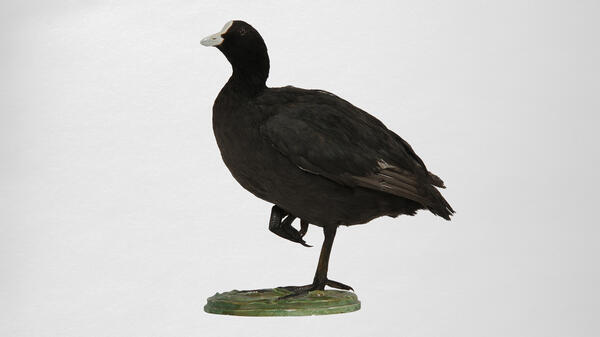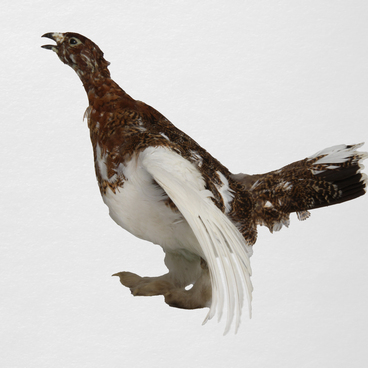The Eurasian, or common coot belongs to the crane-like waterfowl (Gruiformes). It lives in Eurasia from the Atlantic to the Pacific, and is also found in North Africa, Papua New Guinea, Australia and New Zealand.
In northeastern Russia, coots nest up to the 64th parallel north, including territories in the southern part of the Yamalo-Nenets Autonomous Okrug and in the Lena River basin.
The coot is a small bird, its body length does not exceed 38 centimeters, and its wingspan is 23.5 centimeters. The body is slightly flattened from the sides. The plumage of the head, neck and upper body is colored dark gray or black, and there is a grayish tint on the back. The feathers are matte. The chest and belly of the coot are slightly lighter — they are smoky gray.
On the forehead of the coot there is a clearly visible frontal shield which gives rise to the bird’s Russian name meaning “bald”. Its beak is also white — small, sharp and flattened at the sides.
The coot has a short tail, consisting of soft feathers. Its feet are yellowish or orange, with short gray metatarsals and long gray toes. There are no swimming membranes on the toes, but on the sides there are scalloped blades, thanks to which the coot feels confident on the water.
Males look larger and darker than females; they have a larger shield on the forehead. The range of sounds emitted by the coot is relatively wide and differs markedly in males and females. The female screams louder and louder. However, unlike many other birds, the coots do not use sound signals when courting or to indicate nesting territory.
The coot lives in reservoirs with fresh or slightly salted water — lakes, floodplains and river deltas, estuaries. For wintering, it chooses sea bays, large open lakes and reservoirs. And during the nesting period, it avoids fast streams, open water and great depths, lives in shallow water and near abundant vegetation — it prefers thickets of reeds, cattails, sedges or reeds.
Usually a coot nest rests on the bottom with its base, but it can also be completely floating, partially leaning on plants. The female and the male build the nest together from the leaves and stems of last year’s grasses, so outwardly it looks like a rough loose heap. During nesting, coots are very aggressive: they carefully guard their territory from any other birds.
Coot forages equally well both on the shore and on the water. The basis of the bird’s food diet is plant food — shoots and fruits of aquatic plants: duckweed, stonewort. The coot also eats animal food, but very little. It hunts for shellfish and fish, eats eggs of other water birds, and sometimes takes food from ducks and swans.
In northeastern Russia, coots nest up to the 64th parallel north, including territories in the southern part of the Yamalo-Nenets Autonomous Okrug and in the Lena River basin.
The coot is a small bird, its body length does not exceed 38 centimeters, and its wingspan is 23.5 centimeters. The body is slightly flattened from the sides. The plumage of the head, neck and upper body is colored dark gray or black, and there is a grayish tint on the back. The feathers are matte. The chest and belly of the coot are slightly lighter — they are smoky gray.
On the forehead of the coot there is a clearly visible frontal shield which gives rise to the bird’s Russian name meaning “bald”. Its beak is also white — small, sharp and flattened at the sides.
The coot has a short tail, consisting of soft feathers. Its feet are yellowish or orange, with short gray metatarsals and long gray toes. There are no swimming membranes on the toes, but on the sides there are scalloped blades, thanks to which the coot feels confident on the water.
Males look larger and darker than females; they have a larger shield on the forehead. The range of sounds emitted by the coot is relatively wide and differs markedly in males and females. The female screams louder and louder. However, unlike many other birds, the coots do not use sound signals when courting or to indicate nesting territory.
The coot lives in reservoirs with fresh or slightly salted water — lakes, floodplains and river deltas, estuaries. For wintering, it chooses sea bays, large open lakes and reservoirs. And during the nesting period, it avoids fast streams, open water and great depths, lives in shallow water and near abundant vegetation — it prefers thickets of reeds, cattails, sedges or reeds.
Usually a coot nest rests on the bottom with its base, but it can also be completely floating, partially leaning on plants. The female and the male build the nest together from the leaves and stems of last year’s grasses, so outwardly it looks like a rough loose heap. During nesting, coots are very aggressive: they carefully guard their territory from any other birds.
Coot forages equally well both on the shore and on the water. The basis of the bird’s food diet is plant food — shoots and fruits of aquatic plants: duckweed, stonewort. The coot also eats animal food, but very little. It hunts for shellfish and fish, eats eggs of other water birds, and sometimes takes food from ducks and swans.



